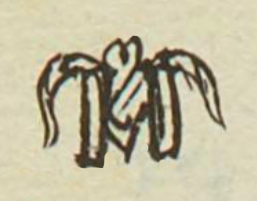Tecpanecatl (MH591r)
This black-line drawing of the compound glyph for the personal name Tecpanecatl ("Person Associated with the Tecpan, or Palace") is attested here as a man's name. Alternately, it could be an occupation or title. The tecpan was a palace of a lord (tecuhtli). The name's ending, -ecatl, suggests that the person had an affiliation with a tecpan or tecpancalli. as graciously suggested by Marc Thouvenot in a personal communication, 30 September 2024, the Tecpan- start to the name seems to be provided in the form of a phonetic indicator, a cuauhtecpantli, a wooden structure like a fence or railing. The right and left sides seem to be upright wooden beams. A triangular point appears at the center-bottom of the device. Between the beams is a horizontal stone with its typical curling ends and diagonal stripes. The stone provides another phonetic element, this one for the start of the name or title ("Te-"). Bending out and away from the tops of the two upright beams are perhaps ropes (mecatl), a near homophone for the -ecatl suffix. Thus, this compound is fully phonographic.
Stephanie Wood
A range of examples of glyphs for Tecpanecatl appear below. Most include this cuauhtecpantli shape. A few also include ropes (mecatl).
Stephanie Wood
antonio tecpanecatl
Antonio Tecpanecatl
Stephanie Wood
1560
Jeff Haskett-Wood
government, gobierno, palacio real, stones, piedras, títulos, nombres de hombres

Tecpanecatl, a name and a title, https://nahuatl.wired-humanities.org/content/tecpanecatl
tecpan, a ruler's palace, https://nahuatl.wired-humanities.org/content/tecpan
tecpancal(li), a palace or a royal home, https://nahuatl.wired-humanities.org/content/tecpancalli
-ecatl (affiliation suffix), typically added to a place ending in -pan, https://nahuatl.wired-humanities.org/content/ecatl-0
cuauhtecpan(tli), a wooden screen, lattice, grate, grille, railing, https://nahuatl.wired-humanities.org/content/cuauhtecpantli
tepozcuauhtecpan(tli), an iron railing, https://nahuatl.wired-humanities.org/content/tepozcuauhtecpantli
posiblemente, Título u Oficio en el Palacio
Stephanie Wood
Matrícula de Huexotzinco, folio 591r, https://www.loc.gov/resource/gdcwdl.wdl_15282/?sp=261&st=image
This manuscript is hosted by the Library of Congress and the World Digital Library; used here with the Creative Commons, “Attribution-NonCommercial-ShareAlike 3.0 License” (CC-BY-NC-SAq 3.0).






